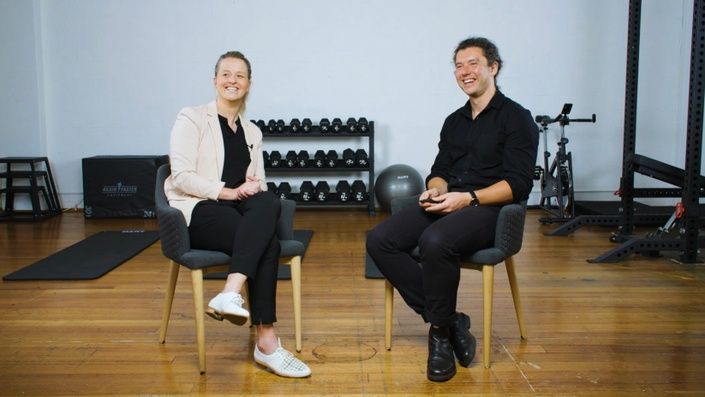Introduction
The Running Injuries: Calf Injury Masterclass, taught by Dr Brady Green and Dr Brooke Patterson, delivers a rigorous summary of calf injuries in runners, incorporating empirical evidence with practical examples and real-world experience. This position statement provides clinically relevant, actionable information that may be useful to health professionals.
Part 1: Assessment and Diagnosis
Unlike many other soft tissue injuries, calf strains do not necessarily require rapid speed, acceleration, or deceleration to occur, with nearly half of calf injuries occurring without a specific mechanism of injury. Further to this, analysing predisposing risk factors such as higher age and reduced running capacity can help to explain the cause of injury. Lastly, it’s important to determine worse prognostic factors such as soleus strain, aponeurotic disruption, and a running-related mechanism to help with timeframes and decision making.
- Soleus strains typically occur during a gradual onset of symptoms with no specific mechanism, whilst gastrocnemius injuries are more likely to occur during a high velocity incident.
- The subjective assessment should focus on 1) the presenting injury, including the mechanism of injury and descriptors of pain, 2) the injured athlete generally, including their injury history and recent periods changes in load, and 3) the injury context such as the demands of the sport and changes to exposure such as running surfaces.
- The objective assessment should encompass observation, palpation including measuring the vertical length of tenderness, stretch tolerance, isolated calf function in bent knee and straight knee positions, as well as dynamic calf capacity in plyometric and locomotive activities.
Part 2: Early-Mid Rehab
Calf rehabilitation is not linear, as specific considerations need to be made for the type, location and severity of injury, sporting demands and individual impairments. Whilst single leg calf raises are highly effective, rehab should go above and beyond this and explore power and ballistic qualities in different planes of movement, maximal strength and much more. Pre-existing deficits along the kinetic chain should also be addressed.
- Athletes remain at risk of re-injuring their calf for up to 4 months following return to play post injury; physios must educate players on the importance of continual and high quality rehab beyond the timeframe of their pain or injury.
- Rehab should reflect the demands of the athlete’s sport and adequately prepare them for this, as well as their unique injury profile including their age, injury history, muscle injured and exposure to how they initially injured their calf.
- Single leg strength should be the foundation for dynamic strengthening through exercises such as straight knee and bent knee calf raises, single leg hops, lateral hops, and walking lunges.
Masterclass Preview
Watch this free 15 minute preview where Dr Brady Green highlights the important components of his objective assessment when assessing patients with calf pain.
Part 3: Late Stage Rehab and Return to Sport
Returning to running should have clear objective criteria and clear principles around its implementation. E.g., scheduling off-field strength and plyometric work after running and running on alternate days to begin with. This stage of rehab also brings rise to heavy strength work, and athletes should aim to achieve 1.5x their bodyweight on a smith machine single leg calf raise. Beyond strength, our rehab must continue to build on other qualities such as power and exposure to high speed running to replicate the physical demands of their sport.
- An athlete can be cleared to run once they 1) achieve a given strength threshold, e.g., on single leg calf raise capacity, 2) they are tolerant of repeat hopping, and 3) there is absence of other clinical signs such as pain on a knee to wall test.
- The decision to return to play should factor in 1) symptom resolution and psychological readiness, 2) no residual clinical signs or symptoms, 3) normalised strength and power qualities, 4) adequate conditioning and exposure to sporting demands, and 5) successful re-integration into full training for at least 1 session.
- It’s crucial to continue to heavily load the in-injured side throughout the rehabilitation process to maintain strength, power, and other athletic qualities and to reduce the risk of future injuries.
Part 4: Injury Prevention
The calf’s unique anatomy and functional role pose significant challenges when trying to prevent injuries of the calf. Further to this, our approach must account for additional factors including on- field load, isolated calf qualities, global athletic qualities across the body, and sport specific exposure. Given the relatively high recurrence of calf injuries, the strategies implemented should ideally be staples of the athlete’s program well beyond their injury.
- Exercises focusing on endurance, maximum strength, mobility and plyometrics are helpful, but may be limited in their preventative effect if we ignore on-field load which is potentially more important.
- Whilst a lot of recurrences of calf injuries are due to unmodifiable risk factors such as age or history of calf injury, we must understand and intervene upon the modifiable risk factors which underpin these. E.g., reduced strength and power capabilities due to a recent calf injury.
- Important benchmarks to continue to track to aid with prevention include maximal strength, single leg calf raise capacity, vertical and horizontal plyometric qualities such as in hop tests, their loading history and much more.


